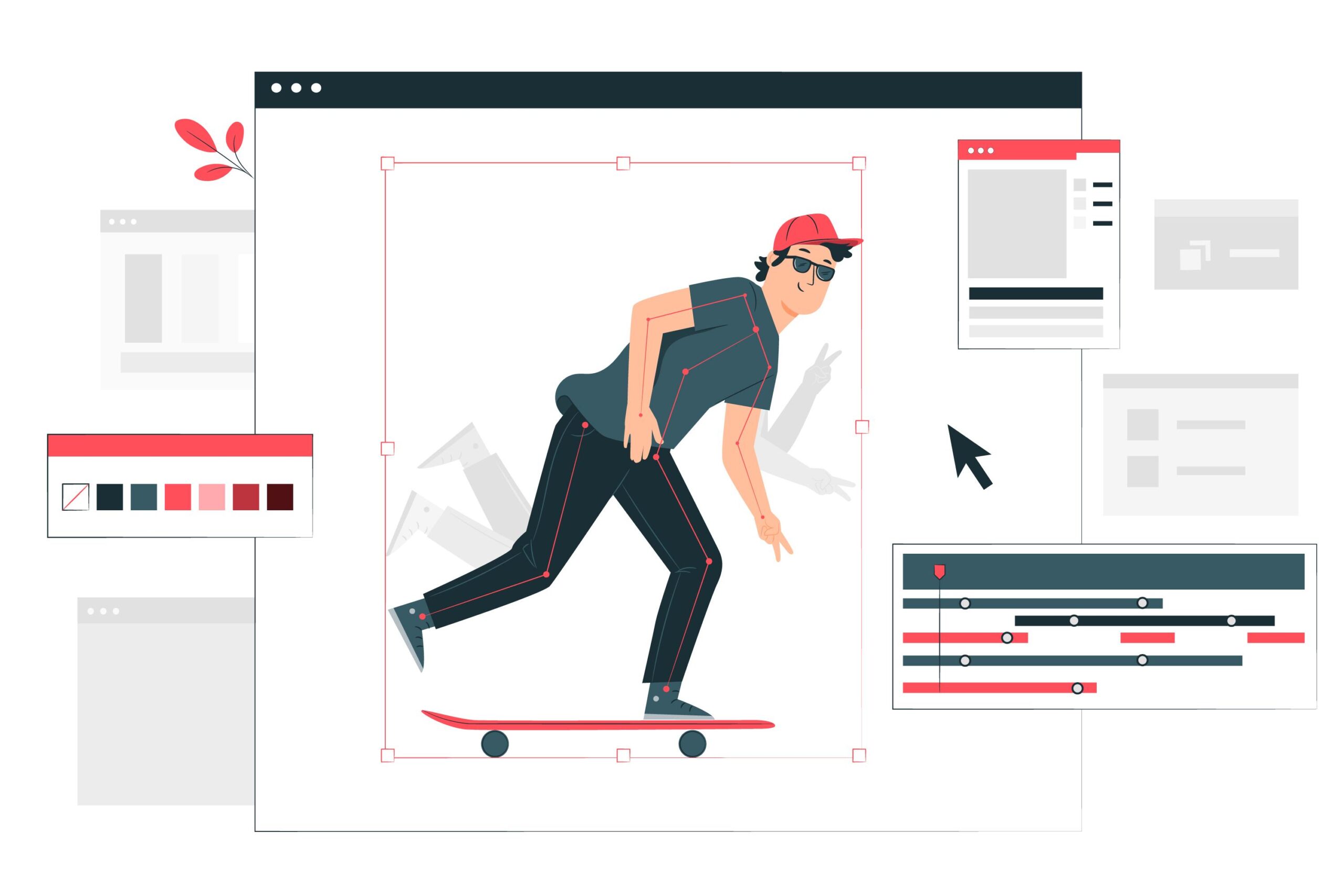Are you tired of static, lifeless web pages? If you want your website to stand out and leave a lasting impression on visitors, you need to tap into the magic of web animations. In this article, we’re going to dive deep into the captivating world of web animations and explore how they can transform your website from static to spectacular!
Table of Contents
What Are Web Animations?
Let’s start with the basics! Web animations are like the fairy dust that sprinkles life onto your web pages. They are dynamic visual effects created using a combination of HTML, CSS, and JavaScript, transforming your static website into an interactive and engaging experience.
The Building Blocks of Web Animations
HTML and CSS: The Dynamic Duo
HTML (Hypertext Markup Language) and CSS (Cascading Style Sheets) are the dynamic duo that forms the foundation of web development. HTML structures your content, while CSS styles it. These two languages work hand in hand to create the visual elements of your website, including animations.
JavaScript: The Animator’s Toolkit
JavaScript is like the wizard’s wand in the world of web animations. It’s a versatile programming language that allows you to add interactivity and animation to your web pages. With JavaScript, you can bring elements to life, create stunning transitions, and even build complex animations.
The Choreography of CSS and JavaScript
The real magic happens when you combine HTML, CSS, and JavaScript to create intricate web animations. For instance, you can have a button that changes color when you hover over it (CSS transition) and then explodes into confetti when clicked (JavaScript animation). The possibilities are limited only by your imagination!
- CSS Transitions and Animations: CSS handles the initial styling and smooth transitions. You can define properties like duration, easing, and delay for transitions, creating fluid, eye-catching effects.
- JavaScript Control: JavaScript takes the lead when it comes to more complex animations. It can dynamically apply CSS styles, listen for user interactions, and trigger animations based on specific events.
Types of Web Animations
Web animations come in various flavors, each adding its own touch of magic to your website:
- Transitions: These are subtle animations that occur when an element changes state, like a button changing color when you hover over it.
- Transformations: Transformations are all about changing an element’s size, position, or rotation. Think of it as the web page’s shape-shifting ability.
- Keyframe Animations: With keyframes, you have complete control over an element’s movement. You define specific points in time where an element changes, allowing for complex animations like bouncing or spinning objects.
- Scroll Animations: Scroll animations are like scrolling through a storybook. As you scroll down the page, elements appear, fade in, or move into view, creating a captivating narrative.
How Do Web Animations Work?
Now that you know what web animations are, let’s take a peek behind the curtain and see how the magic happens!
The Spellbinding World of CSS Animations
CSS animations are like the enchanting spells that can breathe life into your website. They are relatively simple to implement and don’t require much JavaScript expertise. Here’s a look at how CSS animations work their magic:
Keyframes: The Animation Blueprint
Keyframes are the secret recipe behind CSS animations. They define the intermediate stages of an animation. By specifying keyframes, you can control how an element changes over time. For example, you can create a keyframe animation that smoothly fades an image in and out.
Transitions: The Elegance of Change
Transitions are the elegant way to add animation to properties that have intermediate states, such as color, size, and opacity. With just a few lines of CSS, you can make elements smoothly transition from one state to another. It’s like watching a magic trick unfold before your eyes!
Animating CSS Properties
CSS animations can animate a wide range of properties, from simple things like color changes to more complex transformations like rotations and scaling. You can even animate the position of elements, making them slide or bounce across the screen. The possibilities are endless!
Now that you’ve got a taste of the CSS magic, let’s move on to JavaScript animations, where the real enchantment happens!
Mastering JavaScript Animations
JavaScript animations give you ultimate control over your website’s animations. With the power of JavaScript, you can create dynamic and interactive animations that captivate your audience. Here’s how to do it:
The Document Object Model (DOM)
The DOM is like the magic portal to your web page’s content. JavaScript can access and manipulate the DOM to create animations. You can move elements, change their attributes, and even create entirely new elements on the fly. It’s like having a magic wand to transform your website!
Request Animation Frame: Smooth as Butter
To create fluid animations that run at the optimal frame rate, JavaScript offers the “requestAnimationFrame” function. It ensures that your animations are buttery smooth, even on devices with varying processing power. No more jittery animations to spoil the magic!
Libraries and Frameworks: Power Boosters
If you want to take your JavaScript animations to the next level, there are libraries and frameworks like GreenSock Animation Platform (GSAP) and Three.js. These tools provide pre-built animations, 3D capabilities, and much more. They’re like having a spellbook full of advanced animation techniques!
Animate Anything and Everything
One of the most enchanting aspects of web animations is that you can animate almost anything on your web page. Here are some examples:
- Text: Make your headlines pulse, fade in and out, or even form words letter by letter.
- Images: Create mesmerizing image sliders, zoom effects, or 3D rotations.
- Buttons: Give buttons a lively personality by adding hover effects or click animations.
- Backgrounds: Animate background images or gradients to create a dynamic backdrop for your content.
Why Web Animations Are Essential
Now that you have a grasp of what web animations are and how they work, let’s explore why they are absolutely essential in today’s digital landscape.
Captivate Your Audience
In a world where attention spans are shorter than ever, web animations act as your secret weapon to captivate your audience. They add a touch of whimsy and surprise, keeping visitors engaged and encouraging them to explore your site further.
Tell Your Story
Web animations can transform your website into a captivating storytelling platform. With scroll animations, you can guide users through a narrative, revealing content as they scroll. It’s like telling a story one page at a time, keeping your audience hooked!
Elevate User Experience
User experience (UX) is paramount in web design, and web animations play a significant role in enhancing it. They provide visual feedback, making interactions more intuitive. For example, when a user submits a form, an animated checkmark can reassure them that their action was successful.
Brand Identity and Recognition
Web animations can be an extension of your brand’s identity. Consistent animation styles can make your website memorable and reinforce your brand recognition. Think of them as the digital signature of your online presence!
Convey Information Creatively
Animations are not just eye candy; they can also convey information creatively. For instance, you can use animations to illustrate complex concepts, show data trends, or provide step-by-step instructions in an engaging way.
Tips for Effective Web Animations
Creating effective web animations requires finesse. Here are some tips to ensure your animations hit the mark:
- Keep It Subtle: Less is often more when it comes to web animations. Subtle animations can add elegance and sophistication without overwhelming your visitors.
- Match Your Brand: Ensure that your animations align with your brand’s personality and message. Consistency is key in maintaining a cohesive online identity.
- Optimize for Performance: Speed matters in the online world. Optimize your animations to load quickly, ensuring a seamless user experience.
FAQs: Unveiling More about Web Animations
Speed matters in the online world. Optimize your animations to load quickly, ensuring a seamless user experience.
Q1: Are web animations resource-intensive?
They can be, but it depends on how you implement them. Simple animations, like hover effects, are usually lightweight. However, complex animations with high-resolution graphics may require more resources. It’s essential to optimize your animations to ensure smooth performance.
Q2: Do web animations work on mobile devices?
Absolutely! Web animations can be designed to work seamlessly on mobile devices. Responsive design principles ensure that your animations adapt to different screen sizes and touch interactions.
Q3: Are there libraries or frameworks for creating web animations?
Yes, there are! Libraries like GreenSock Animation Platform (GSAP) and CSS animation frameworks like Animate.css can simplify the process of creating web animations. These tools provide pre-built animations and make it easier to add animation to your website.
Q4: Are web animations accessible to all users?
Accessibility is crucial in web design. When using web animations, it’s essential to consider users with disabilities. Provide options to disable animations, ensure that animations don’t cause seizures or motion sickness, and use ARIA roles to make animations accessible to screen readers.
Q5: Can web animations slow down my website?
If not optimized properly, web animations can affect your website’s performance. To avoid this, use efficient coding practices, minimize the use of heavy graphics, and test your animations on various devices and browsers to ensure they run smoothly.
Q5: Can I create animations without coding skills?
While having coding skills can be advantageous, there are user-friendly animation tools and plugins available that allow you to create animations with little to no coding knowledge. It’s like having training wheels for your web animations!
The True Magic of Web Animations
In the ever-evolving digital landscape, web animations are the enchanting spells that can make your website truly magical.
Remember, web animations are not just about making things move; they’re about creating memorable experiences for your users. When used thoughtfully and creatively, animations can engage, inform, and delight your audience like never before.
So, don’t be afraid to experiment, to dream big, and to let your creativity run wild. With web animations, you have the power to captivate your audience and leave them spellbound.
Remember: The more you practice, the more enchanting your creations will become. Unveiling the Magic of Web Animations is not just about making your website look pretty; it’s about making it unforgettable!




